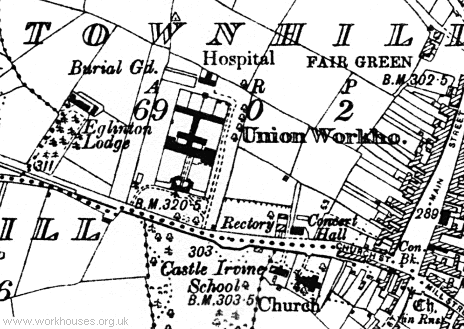Lowtherstown, Co. Fermanagh
Lowtherstown (now known as Irvinestown) Poor Law Union was formally declared on the 14th September 1840 and covered an area of 118 square miles. Its operation was overseen by an elected Board of Guardians, 18 in number, representing its 9 electoral divisions as listed below (figures in brackets indicate numbers of Guardians if more than one):
Co. Fermanagh:
Castle Archdale (2), Clonelly (2), Dromore, Kesh (2), Lack (2), Lowtherstown (4), Tubbrid (2).
Co. Tyrone:
Moorfield (2), Trillick.
The Board also included 6 ex-officio Guardians, making a total of 24. The Guardians met each week on Wednesday at noon.
The population falling within the Union at the 1831 census had been 32,198 with divisions ranging in size from Dromore (population 2,180) to Lowtherstown itself (6,377).
The new Lowtherstown Union workhouse was erected on a five-acre site at the west of Lowtherstown. Designed by the Poor Law Commissioners' architect George Wilkinson, the building was based on one of his standard plans to accommodate 400 inmates. Its construction cost £6,710 plus £1,216 for fittings etc. The workhouse was declared fit for the reception of paupers on 28th October 1844 and admitted its first inmates on 1st October 1845. The workhouse location and layout are shown on the 1907 map below.

Lowtherstown workhouse site, 1907.
The buildings followed Wilkinson's typical layout. An entrance and administrative block at the south contained a porter's room and waiting room at the centre with the Guardians' board room on the first floor above. This was later extended at each side to provide children's accommodation and school-rooms.
The main accommodation block had the Master's quarters at the centre, with male and female wings to each side. At the rear, a range of single-storey utility rooms such as bakehouse and washhouse connected through to the infirmary and idiots' wards via a central spine containing the chapel and dining-hall.
During the famine in the mid-1840s, a 40-bed fever hospital was erected at the north of the site. The workhouse had its own burial ground at the west of the site.
At the 1901 census, the population of the Union was 14,095.
In October 1916, the Guardians decided to close the workshouse and hospital as it was proving too expensive to run. The establishment ceased operation on 31 March 1918.
After the workhouse closed, the buildings had a variety of uses including a barracks for the Royal Irish Constabulary and a storage depot for the Lowtherstown Co-operative. The Irvinestown Rural District Council held their meetings there until 1967, when the buildings were demolished and cleared. The Reihill Park housing estate now occupies the site.
Records
Note: many repositories impose a closure period of up to 100 years for records identifying individuals. Before travelling a long distance, always check that the records you want to consult will be available.
- Public Record Office of Northern Ireland, 2 Titanic Boulevard, Titanic Quarter, Belfast BT3 9HQ. Holdings include: Board of Guardians' minute books (1840-1948); Dispensary minute books (1852-99); Workhouse registers (1845-1918); Indoor relief lists (1935-48); Return of births (1846-1918); Return of deaths (1846-1918); Outward letter books (1840-1914); etc.
Bibliography
- The Workhouses of Ulster by Michael H Gould, 1983.
- Workhouses of the North West Edited by Jack Johnston (1996, WEA)
- The Workhouses of Ireland by John O'Connor (Anvil Books, 1995)
- McCusker, Breege (1997) Lowtherstown Workhouse Necarne Press.
Links
- None.
Unless otherwise indicated, this page () is copyright Peter Higginbotham. Contents may not be reproduced without permission.


